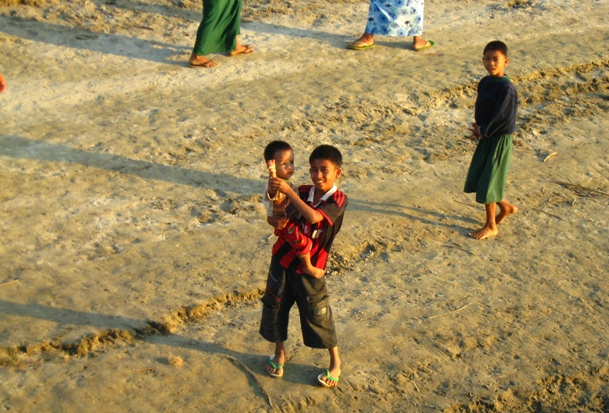"If we [wait], it will be too late and too hard to rehabilitate," said Aung Myint, general-secretary of the Renewable Energy Association Myanmar, which calls on residents in the dry zone to work with agencies to boost tree planting, soil conservation and water management.
The regions of Mandalay, Magway and Lower Sagaing, which comprise the dry zone and experience among the lowest rainfall levels in the country, form the breadbasket for crops that require little rain.
But the maize, cotton, pulses, beans and sesame are threatened by soil breakdown and deforestation occurring at an "alarming" pace, according to U Ohn, from the national NGO, Forest Resource Environment Development and Conservation Association.
The Forest Ministry estimated in 2006 that the region - home to one-third of the country's more than 55 million population - was losing 800 hectares of forest annually, in its most recently submitted report to the UN Convention to Combat Desertification (UNCCD).
Myanmar's forests covered 31,773,000 ha, or 48 percent of the country in 2010. On average, it has lost just over 1 percent of its forest cover every year since 1990, or more than seven million hectares in all, according to the UN Food and Agriculture Organization's 2011 State of the World's Forests report.
The government reported reforesting 117,414ha in the dry zone from 1994-2006, the most recent year for which such data was submitted to UNCCD.
The cultivable land that remains in the dry zone has been broken down through erosion, tree cutting for firewood, poor planting practices, overgrazing and urbanization - which means less food, say local agencies.
"As soil condition is not as good as before, a good yield is not guaranteed," said U Than, a farmer from the zone's Kyauk Pyoke village.
Some of the land has simply stopped producing. "Land degradation in terms of soil erosion and soil fertility loss is quite serious," said Win Myo Thu, managing director of the local NGO, EcoDev.
Food crisis warning
At this pace, a "severe food crisis" could unfold over the next decade if the soil is not saved, said Aung Min Naing, the dry zone's coordinator for the international NGO ActionAid.
While greening efforts are important, boosting food security demands a "comprehensive development effort" to protect the poorest from the impacts of weather variability, said Marcus Prior, World Food Programme's Asia spokesman.
"Vulnerability in this area is cyclical - always more severe during the lean [dry] season, when work is scarce, wages lower and basic food prices higher."
The country's dry season lasts on average from late October to May.
Food consumption was inadequate for 65 percent of families surveyed in Magway Division in December 2009, while 12.1 percent of children under two years old were acutely malnourished in Mandalay Division in August 2009, according to multi-agency surveys.
After the country signed the UNCCD in 1997, the government founded the Dry Zone Greening Department with local and international NGOs.
But need outstrips the limited activities and access.
"The coverage of agencies [working in the dry zone] is still low, less than 30 percent of the total need," said Aung Min Naing.
Thirteen groups are working in the dry zone with US$20 million from the Livelihoods and Food Security Trust fund (LIFT), from 2011-2014 in an effort to boost incomes and agricultural yield.
Spurred by destruction from the 2008 Cyclone Nargis, a group of international donors pledged $100 million to the fund from 2010-2015 to boost incomes and agricultural production.
This is part of a larger plan launched in 2010 that is being finalized to protect the zone's environment, improve water management and dry-land farming practices.
Meanwhile, farmers still remember the impact of a four-month drought in 2009 that further degraded poor soil.
The zone's temperatures average 40-46 degrees Celsius during the hot season from March to May.
"No grass was available then for the cattle," said a farmer from Myinchan District, "We had to travel far, spending day and night in search of cattle fodder."
The pace of deterioration is unforgiving and relentless, and demands an urgent response, said Aung Myint. "By many different means [deterioration] is happening day by day."
The recent flash flood that hit the dry zone, leaving a reported 161 people missing or dead and another 2,657 households homeless, has raised additional food security concerns due to loss of livestock, seeds and household food reserves, according to a 4 November report by the UN Office for the Coordination of Humanitarian Affairs in Myanmar.
lm/pt/mw
This article was produced by IRIN News while it was part of the United Nations Office for the Coordination of Humanitarian Affairs. Please send queries on copyright or liability to the UN. For more information: https://shop.un.org/rights-permissions





